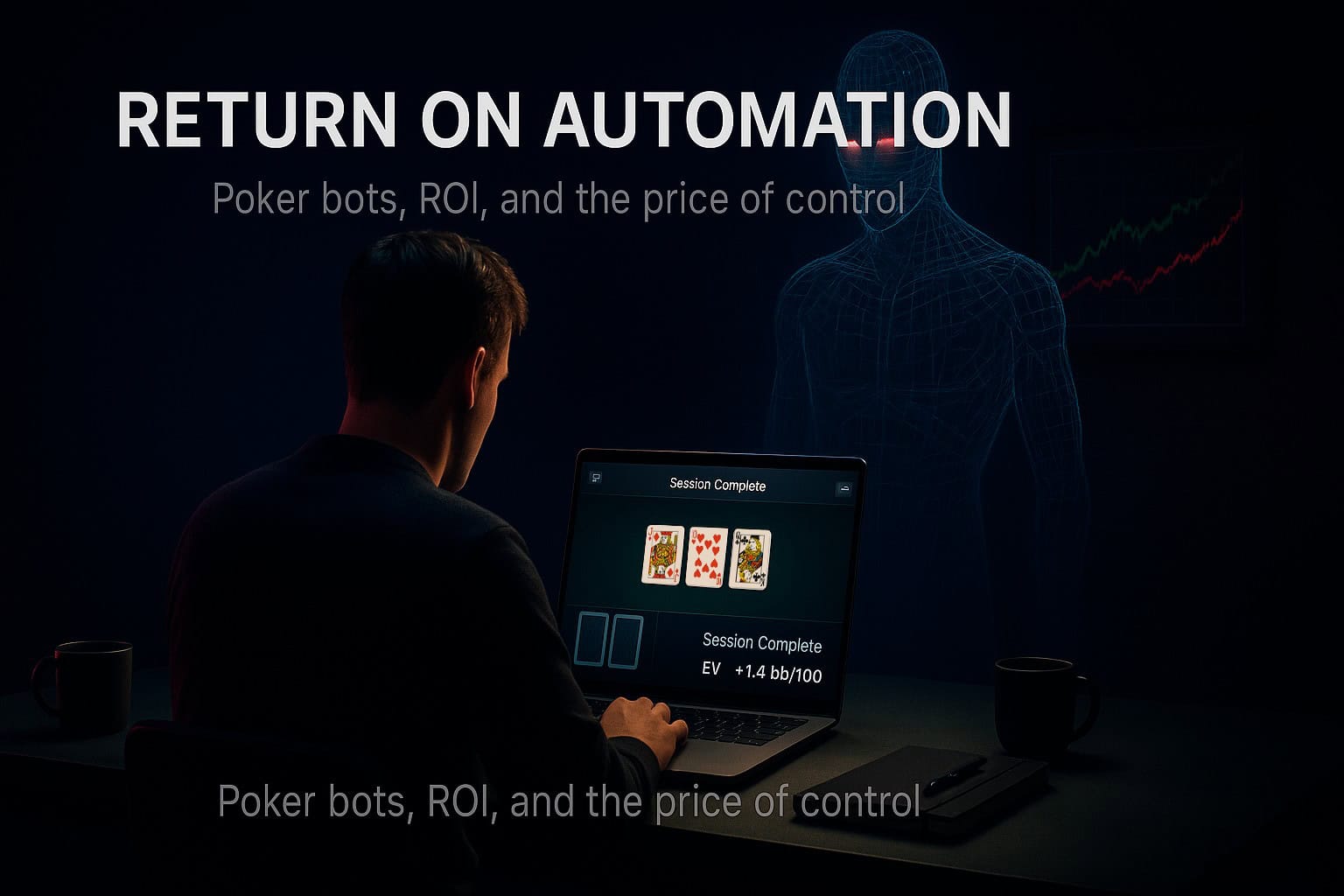
AI Poker Bot ROI: Can Automation Really Pay Off?
There’s no shortage of hype around poker bots.
Automate your play. Run 24/7. Print money while you sleep.
But behind every wild claim about “fully passive poker income” is a much harder question:
What’s the actual poker bot ROI for players who try automation?
In this article, we’ll dig deep into the economics of botting—from setup and maintenance costs to profits, detection risk, and whether the juice is truly worth the squeeze.
What Counts as Poker Bot ROI in 2025?
Let’s define it.
In normal poker, ROI (Return on Investment) =
Profit / Initial Buy-ins or Bankroll
In botting, it’s more complicated:
- You’re investing in software, servers, security layers
- You’re risking bans, resets, and wipeouts
- Your true ROI includes downtime, rebuild cost, and survival rate
So instead of just profit vs buy-ins, think:
ROI = (Profits – Operating Costs – Losses from Detection) / Total Time & Spend
And that equation isn’t nearly as rosy as bot promoters would have you believe.
Startup Costs: Building or Buying a Bot
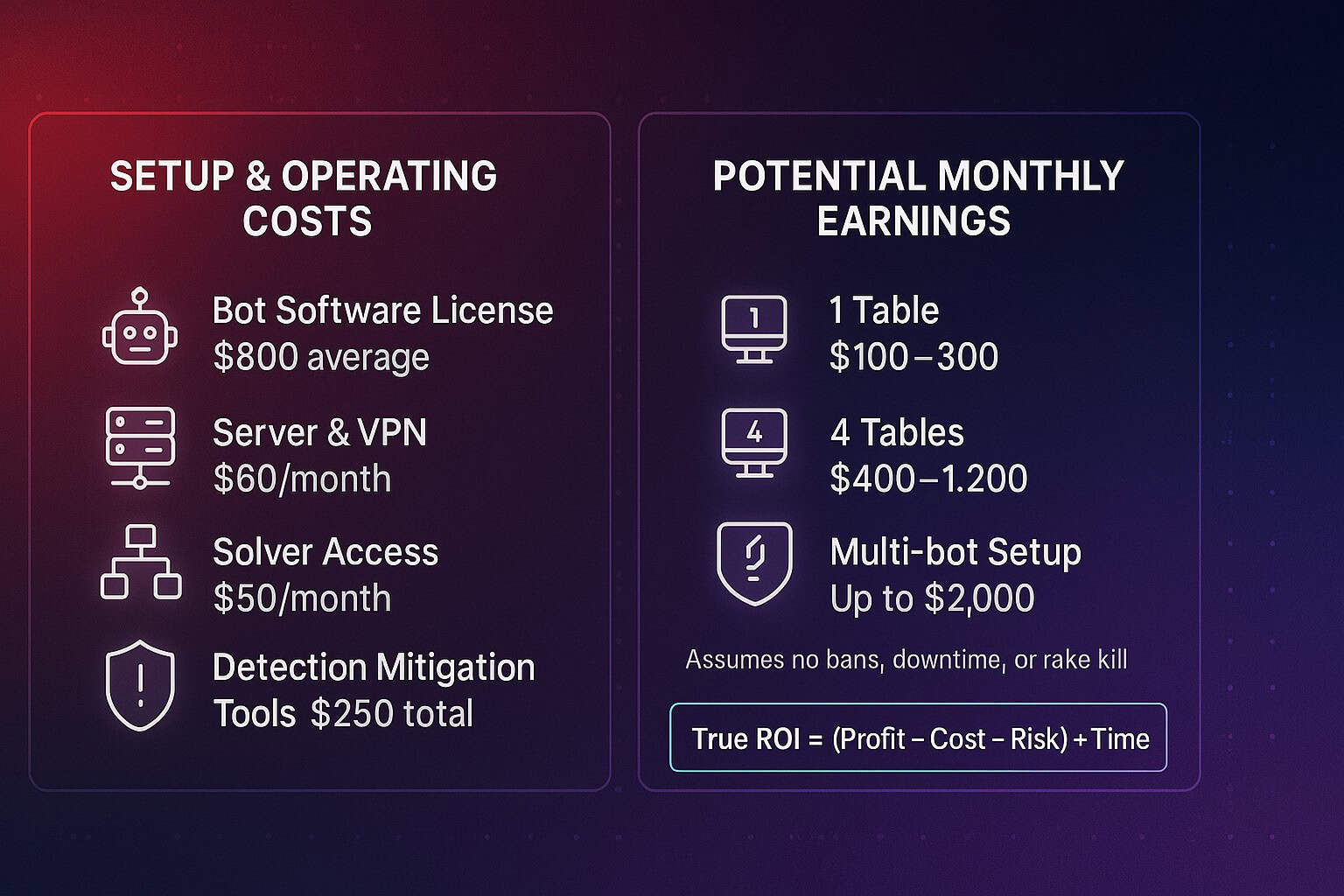
Bots don’t build themselves. Here’s a rough cost breakdown:
| Component | Cost Range |
| Prebuilt bot software | $300–$1,500 |
| Dedicated server/VPN | $10–$80/month |
| Solver backend access | $30–$100/month |
| Screen-scraper config | $200–$800 |
| Evasion tools (mouse, AI delays, etc.) | $100–$300 |
Upfront total: ~$500–$2,000+
Monthly maintenance: ~$100–$250
And that’s assuming you don’t get banned. Factoring these expenses is essential when calculating your true poker bot ROI.
How Much Can a Bot Earn?
Let’s get real.
Most low-stakes bots (NL2 to NL25) earn somewhere between $0.50 to $3.00 per 100 hands if they play well.
With multi-tabling and 24/7 uptime, a good bot might clear:
- ~$100–$300/month (1 table)
- ~$400–$1,200/month (4+ tables, efficient config)
But…
This assumes:
- It survives at least 4–6 weeks
- It avoids being countered by other bots
- It plays on soft, low-regulation networks
If it’s detected and shut down in Week 3? ROI tanks.
If your bot crashes mid-session and starts hemorrhaging stacks? ROI tanks.
If rake or beat-the-rake thresholds aren’t met? ROI tanks.
These survival conditions directly determine whether your poker bot ROI is positive or negative
Risk-Adjusted Poker Bot ROI
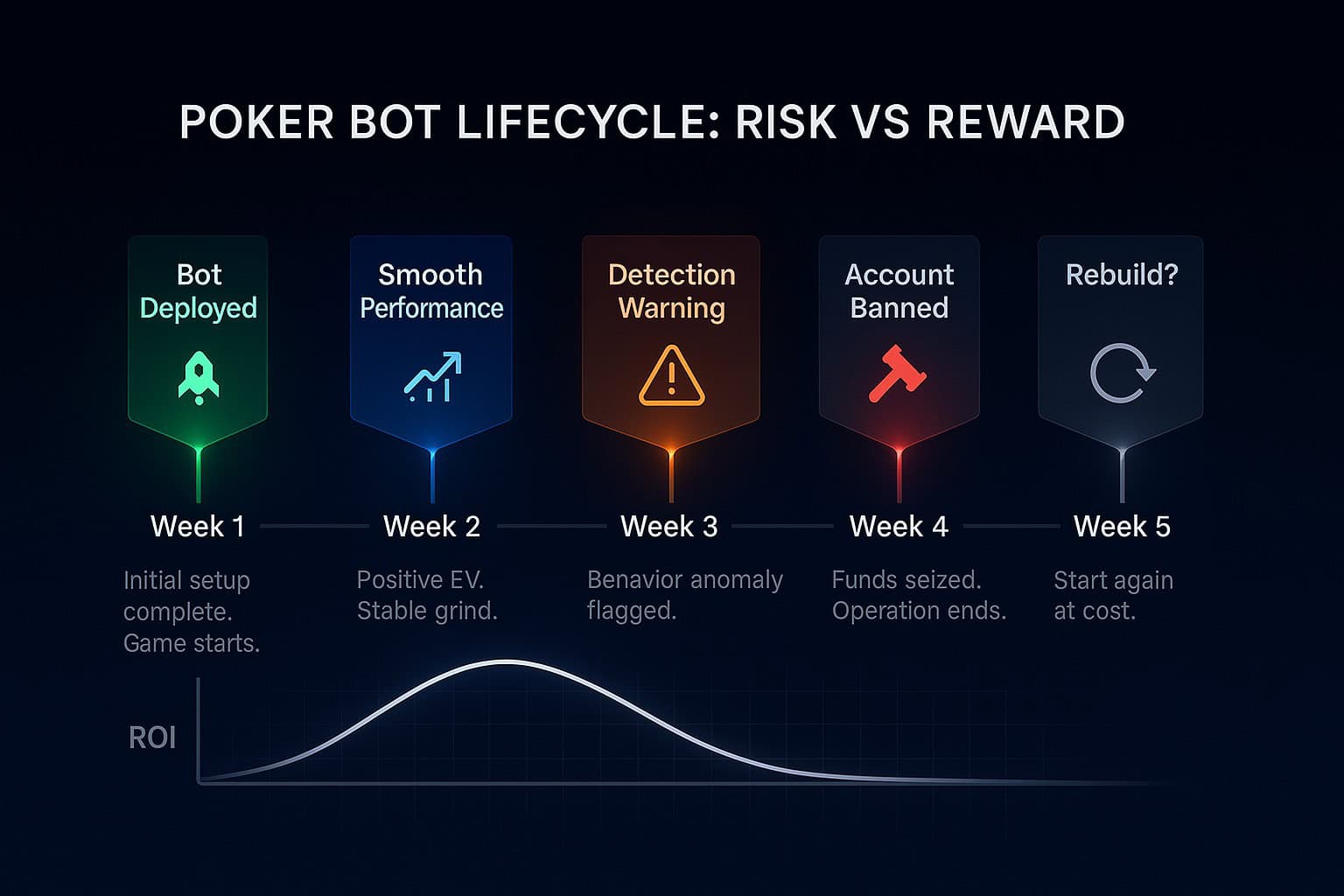
Let’s say you spend $1,200 setting up a mid-tier bot.
It survives 2 months. Plays 12 tables at 10nl. Earns $700 in total before being banned.
At first glance:
ROI = ($700 – $1,200) / $1,200 = -41%
But let’s say you’re running 5 of these bots across different skins.
Only 3 survive to cash out. Total profit = $2,200.
Total setup + maintenance = $6,000.
Now ROI = ($2,200 – $6,000) / $6,000 = -63%
This is not hypothetical. This is typical.
Yes, some operators scale harder. They cycle identities, spoof hardware, use underground peer groups.
But that takes time, tools, and knowledge—none of which are “passive.”
Detection Risk: Your Biggest Cost
The single largest ROI-killer in poker botting? Detection.
Most bans lead to full balance seizure. That means even if your bot was profitable, you never get the funds.
Detection methods now include:
- Click-timing fingerprinting
- Input tracking (e.g. mouse, keyboard devices)
- Solver-pattern match ratios
- Real-time behavioral Turing tests
Even with “undetectable” setups, risk compounds over time. Detection wipes out entire bankrolls, making poker bot ROI look much worse in practice.
You can run undetected bots—you just can’t run them forever.
How Long Do Bots Usually Survive?
From multiple reports and field tests:
| Bot Type | Median Lifespan |
| Script-based (basic) | 1–3 weeks |
| Solver-injected | 3–6 weeks |
| AI mimicry bots | 6–12 weeks |
| Human-assisted hybrid | 12+ weeks |
The most ROI-positive setups tend to be:
- Semi-manual bots (humans assist, reduce detection)
- Mobile-interfaced RTA systems (harder to track)
- Cloud-rotated setups with fresh IPs/hardware
But again—these are not passive. They’re closer to day-trading.
Variance + Rake = Lower Than You Think
Bot winrates are usually calculated in bb/100, but rake is a killer.
A bot making 3bb/100 may:
- Lose 1.5bb/100 to rake at low stakes
- Lose another 0.5bb/100 from table drops
- Net 1bb/100 over time
That’s ~$1/hour… at best. Before factoring in:
- Hardware crashes
- Mistakes in configuration
- Opponent adjustments
For comparison: a decent human player at 10nl can make 3–5bb/100 with proper table selection and dynamic adjustments.
Is Poker Bot ROI Actually Profitable?
Yes—but it’s rare.
High-tier operations use:
- Private networks
- Account leasing
- Constant account cycling
- In-house solvers and click logic models
- Admin support for real-time intervention
These setups resemble businesses, not “botting for fun.”
Most of them:
- Employ teams
- Use dedicated developers
- Have legal firewalls between accounts and operators
If you’re not doing that—you’re probably not profitable long-term.
Hidden ROI Costs People Forget
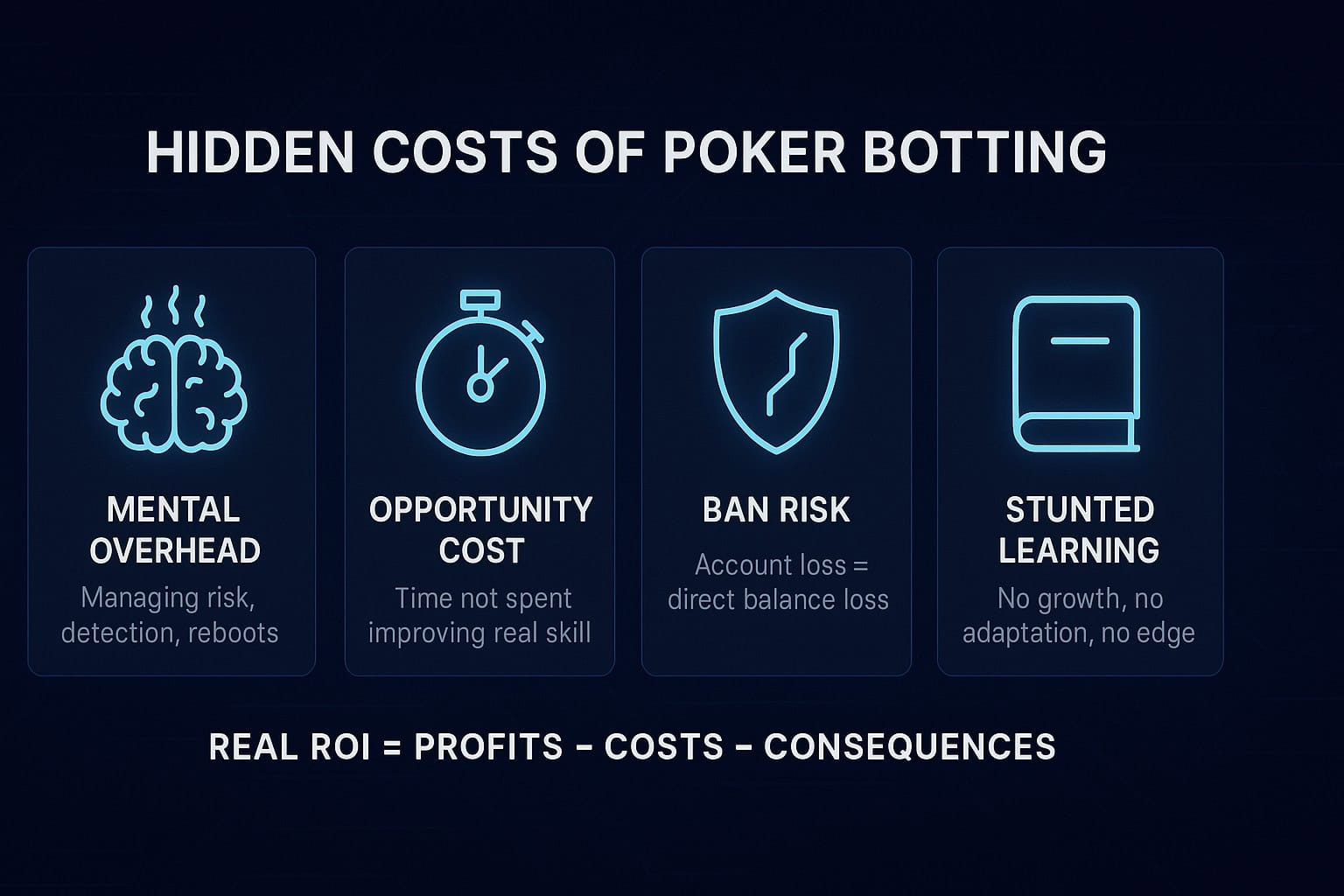
Here’s what botters rarely talk about:
- Mental overhead (stress of hiding, rotating accounts, watching forums)
- Community backlash (if caught, you’re banned for life on most platforms)
- Skill erosion (you stop improving as a player)
- Opportunity cost (what you could’ve earned studying, coaching, or staking)
That’s not a side hustle. That’s a risk-laden operation with a questionable payoff.
Ethical ROI: What If You Used AI to Train, Not Play?
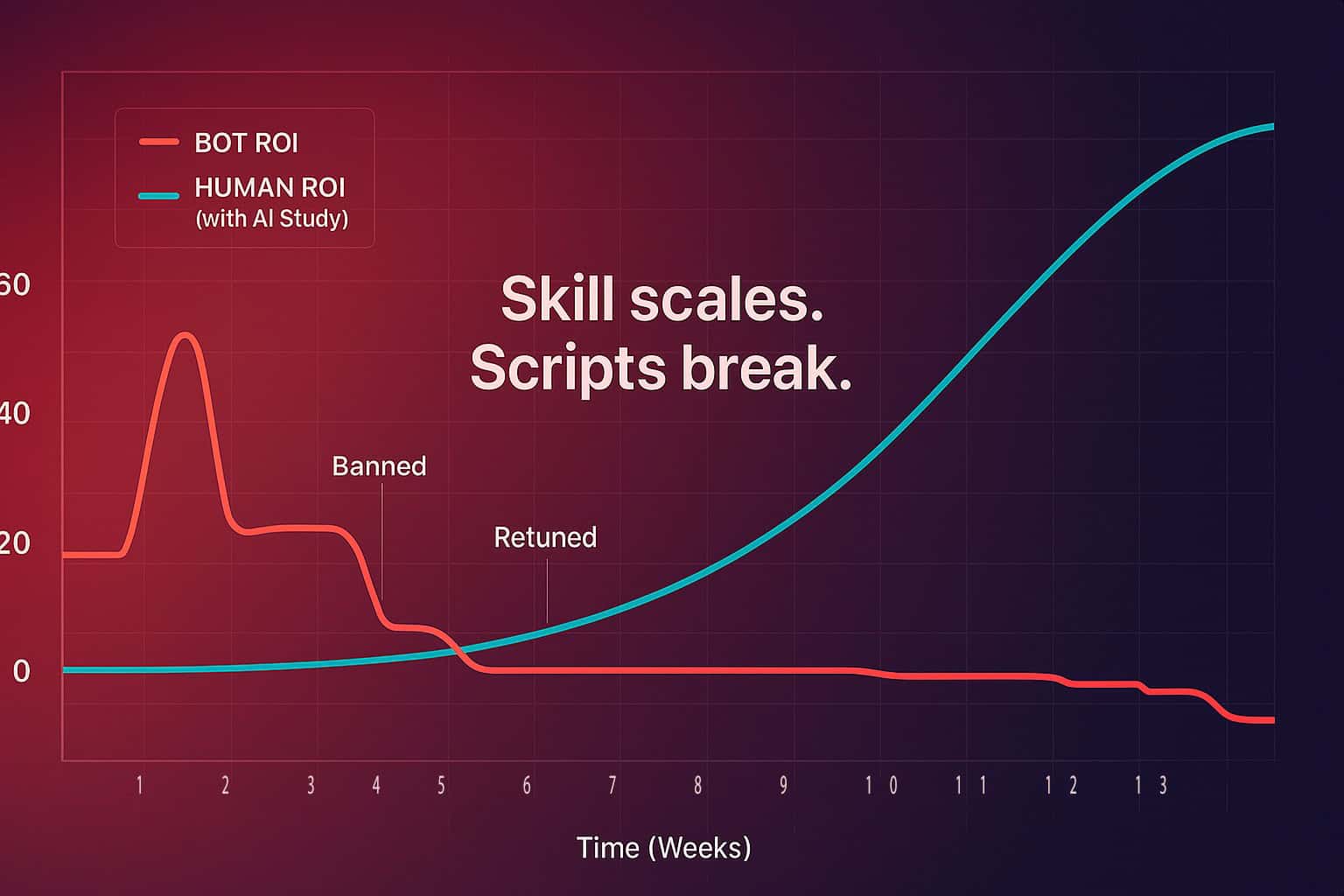
Now here’s the twist.
What if instead of running bots, you used:
- Lucid GTO Trainer
- GTO Wizard with scenario drills
- PokerAlfie in study mode
You invest the same $500–$1,200 into study, solvers, and coaching. You improve at 25nl and 50nl. You earn $800–$1,200/month manually. No bans. No risk. No stress.
Suddenly, your ROI isn’t tied to bans or scripts. It’s tied to skill.
And that ROI? It grows. Month over month.
Final Verdict: Do Bots Pay?
In short?
Sometimes. Briefly. With massive caveats.
For most players, the ROI on poker bots:
- Is short-lived
- Requires constant maintenance
- Has severe downside risk
- Is easily wiped out by one detection event
Unless you’re part of a high-level, team-driven, rotating setup with custom infrastructure—you’re better off using AI for study, not subversion. That’s why most long-term players see better results improving skill than chasing risky poker bot ROI.
Because in poker, the only edge that compounds long-term…
…is the one you build yourself.
